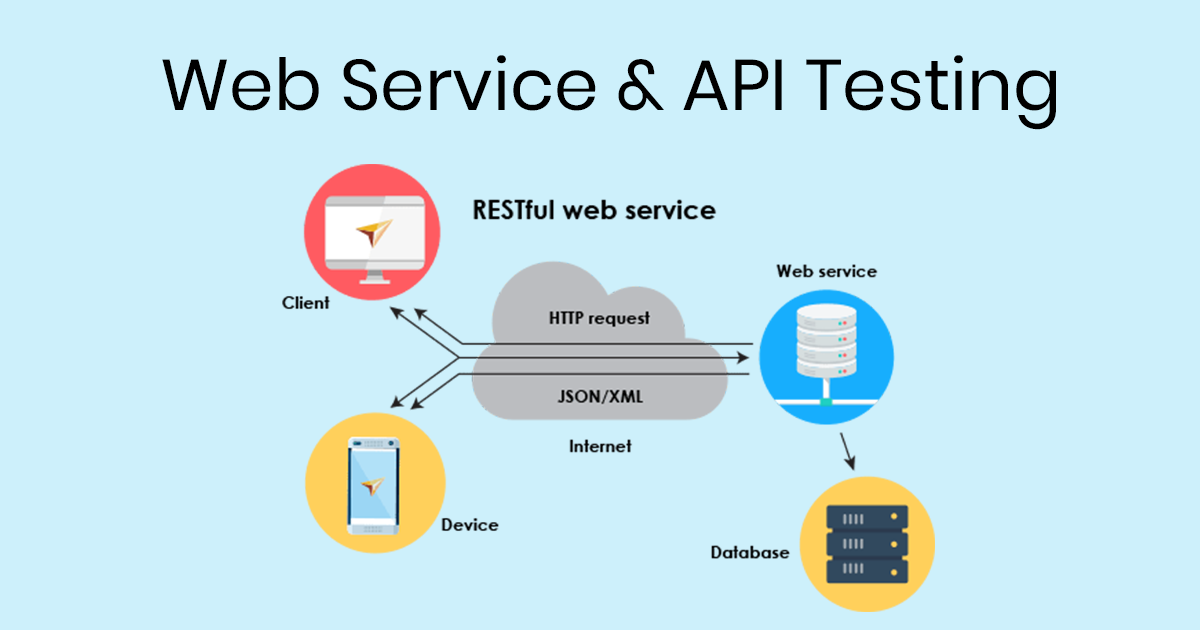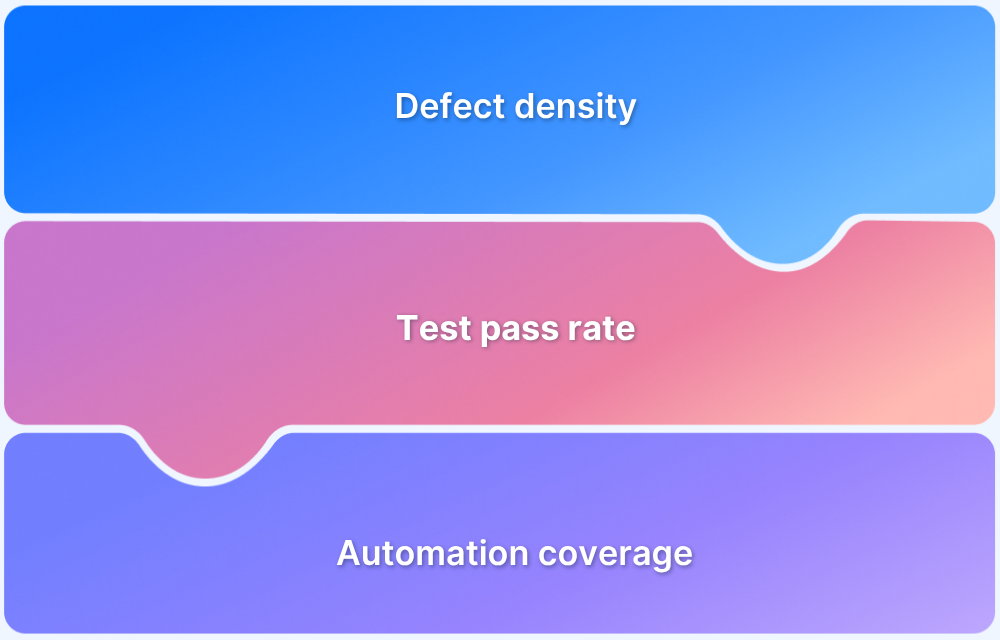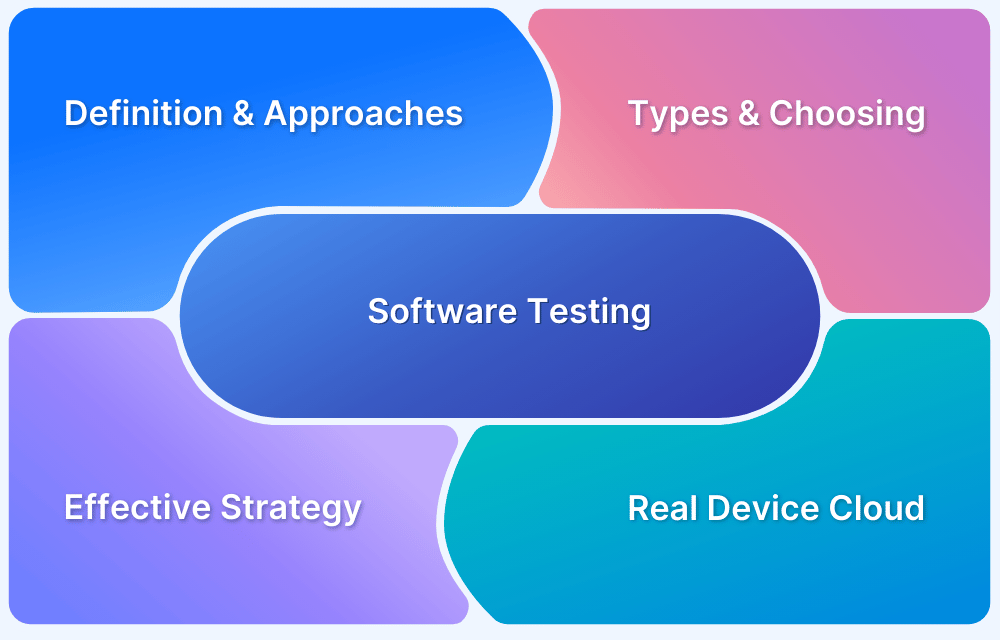With the rise of businesses on the internet, the requirement for dependable and robust web services is rising. That’s where web service testing comes into the picture, which can help ensure your web service is up to par.
Relying on automation testing can help web service developers or experienced testers minimize the hassles and maximize the impact.
But there are multiple vital aspects you need to be aware of in web service testing.
Overview
What is Web Service Testing?
Web service testing is the process of evaluating APIs to ensure seamless communication between software components. It involves verifying API endpoints, parameters, and methods while assessing functional, performance, security, and compliance aspects.
Purpose of Web Service Testing
The primary goal of web service testing is to ensure that APIs work correctly, perform under load, and stay secure. It validates integrations, ensures compliance, and detects vulnerabilities early.
Key Benefits
- Early Defect Detection
- Improved Software Quality
- Faster Development & Deployment
- Minimized Production Failures
- Cost Efficiency
- Seamless Integration
Challenges in Web Service Testing
- Incomplete Documentation: Lack of clarity in API specifications.
- Complex Test Environments: Requires multi-system configurations.
- Dynamic Data Handling: Testing fluctuating data responses is challenging.
- Third-Party Dependencies: Managing integrations can be complex.
- Frequent API Changes: Maintaining test cases for evolving APIs.
- Scalability Testing: Simulating real-world load conditions effectively.
- Performance Testing Issues: Simulating real-world loads is challenging.
- Security Concerns: Ensuring APIs are protected against cyber threats.
This ultimate guide will take you through everything you need to know to become a pro with web service testing.
What is Web Service Testing?
Web service testing involves testing the API of a web service, which defines how different software components interact. It includes testing various aspects of the API, such as the endpoints, parameters, and methods, to ensure that they work as expected and meet the functional requirements.
In addition to functional testing, web service testing also involves performance testing, which assesses the web service’s scalability, reliability, and response times under different load conditions. Security testing is also important in web service testing, as it helps identify and mitigate potential vulnerabilities and threats, such as SQL injection, cross-site scripting, and authentication issues.
Web service testing can be performed using various tools and frameworks, both open-source and commercial. These tools provide a range of functionality for creating test cases, executing tests, and analyzing test results.
Purpose of Web Service Testing
Web service testing aims to ensure that a web service works as intended and meets its functional, performance, and security requirements. Here are some specific reasons why web service testing is important:
- Functional Testing: Verifies that the web service meets its functional requirements by testing API endpoints, parameters, and methods to ensure correct behavior.
- Performance Testing: Assesses the web service’s scalability, reliability, and response times under different load conditions to determine its performance limits.
- Compliance Testing: Ensures that the web service adheres to industry-specific regulations and standards, such as HIPAA or PCI-DSS, to maintain data integrity and security.
- Integration Testing: Confirms that the web service integrates seamlessly with other software systems and components, ensuring smooth interoperability.
- Security Testing: Identifies and mitigates vulnerabilities to protect sensitive data and prevent potential cyber threats or unauthorized access.
Benefits of Web Service Testing
Web service testing provides several benefits for software development teams, including:
- Early Defect Identification: Web service testing helps identify defects early in the development cycle, allowing developers to address issues before they become larger and more costly to fix.
- Ensuring Software Quality: Testing ensures that the web service meets its functional, performance, and security requirements, improving overall software quality and user satisfaction.
- Accelerating Development Process: By identifying and resolving issues early, web service testing can help speed up development, leading to faster time-to-market and competitive advantage.
- Reducing Production Failures: Testing early and often reduces the risk of production failures, which can be costly and damage a company’s reputation.
- Lowering Development Costs: Early defect identification and faster development cycles can reduce development costs, leading to a more efficient and cost-effective development process.
- Enhancing Team Collaboration: Testing helps promote collaboration between development and testing teams, leading to better communication, cooperation, and understanding of the web service and its requirements.
- Ensuring Compliance: Compliance testing ensures that the web service meets specific standards and regulations, reducing the risk of regulatory penalties and legal issues.
Challenges of Web Service Testing
You can encounter multiple challenges while performing web service testing. So, to avoid hiccups during the process, you must be aware of a few major ones:
- Web services may have incomplete or outdated documentation, making it difficult for testers to understand the API’s functionality and requirements.
- It requires complex test environments, including multiple systems and network configurations, which can be difficult to set up and maintain.
- Your web services can return dynamic data, which can be difficult to test since the data changes frequently.
- Web services may rely on third-party systems or external data sources, which can introduce complexity and dependencies that are difficult to manage.
- Integration testing can be complex, especially with other systems and software components with different requirements and configurations.
- As web services evolve and change over time, it can be challenging to maintain and update the test suites to keep up with these changes.
- Performance testing can be challenging for web services, especially when testing at scale. It may be difficult to simulate real-world usage scenarios and handle large volumes of requests.
- Web services may be vulnerable to security threats, making it necessary to perform comprehensive security testing.
By understanding these challenges and taking appropriate steps to address them, development and testing teams can ensure that web services are thoroughly tested and meet their functional, performance, and security requirements.
Web Services Automation Testing
Automation testing is an essential part of the development process, as it helps reduce the time and cost required for testing and ensures that web services are thoroughly tested for defects and issues. Here are some important aspects of web services automation testing:
- Test framework: A test framework is a set of guidelines and procedures for creating and maintaining automated tests. There are several test frameworks available for web services automation testing.
- Test environment: A test environment is a hardware, software, and network configuration setup for automated tests. Test environments must be created and configured to match the production environment as closely as possible.
- Test cases: Test cases are sets of instructions and expected outcomes used to test web services. They should be designed to cover all possible scenarios and edge cases.Know about: How to write test cases with examples?
- Test data: Test data is the input data required for running automated tests. It should be generated or collected to cover all possible scenarios and edge cases.
- Test execution: Test execution involves running automated tests in the test environment using the test framework. The results of the test execution are then recorded and analyzed to identify defects and issues.
- Test reporting: Test reporting involves generating reports that provide insights into the results of the test execution. Reports should be clear and concise and include information on the test cases, test data, and defects found.
- Continuous testing: Continuous testing involves running automated tests continuously as part of the development process.
Read More: What is Continuous Testing in DevOps
By using the right strategies and tools, you can create and maintain automated tests that thoroughly test web services for faults.
Preparing for Web Service Testing
Preparing for web service testing involves several important steps that must be taken to ensure that the testing process is effective and efficient.
Prerequisites for Web Service Testing:
- Defining Test Objectives
- Selecting Test Tools
- Defining Test Data Requirements
- Identifying Test Environment
- Creating a Test Plan
1. Defining Test Objectives
The first step in preparing for web service testing is to define clear and specific test objectives. Test objectives should outline the goals of the testing process, including the functionality, performance, and security requirements of the web service. Here’s more depth on this:
- Functionality: Test objectives should focus on the functional requirements of the web service, including its ability to perform the required tasks and produce the expected output.
- Performance: They should also consider the performance requirements of the web service and its capacity to handle the expected load and respond within acceptable time frames.
- Security: The ability of the web services to protect sensitive data and prevent unauthorized access can’t be ignored.
- Compliance: It’s important that test objectives consider regulatory or compliance requirements that the web service must meet.
Defining clear and specific test objectives helps ensure that the testing process is focused and effective and that the web service meets its requirements and objectives.
2. Selecting Test Tools
Once the test objectives have been defined, the next step is to select the appropriate testing tools. The selected tools should match the requirements and objectives of the testing process.
Several tools are available for web service testing, including automated, manual, and performance testing tools. You can access our powerful testing ecosystem to simplify your browser and app testing process with products like BrowserStack Automate, Live, App Live, and App Automate.
Use different real device-browser-OS combinations available on the platform, as BrowStack offers over 3000 real devices and browsers for simplifying your testing process.
Here are some factors to consider when selecting test tools for web service testing:
- Protocol: The tools should support the protocols used by the web service. This includes protocols such as SOAP, REST, and JSON.
- Automation: Automated testing tools can help streamline the testing process, reduce errors, and save time. If automation is a priority, the tools chosen should be able to support automation.
- Reporting: The tools should provide detailed reports on the results of the testing process, including information on test cases, test results, and any issues found.
- Integration: The tools should be able to integrate with other testing tools and frameworks, such as continuous integration (CI) and continuous delivery (CD) systems.
Learn how to setup a CICD Pipeline
By considering the factors mentioned above and researching the available tools, development and testing teams can choose the best tools for their specific needs and objectives.
3. Defining Test Data Requirements
Test data is the input data used to run tests on the web service. Defining the test data requirements is important before the testing process begins. The test data should represent the production environment and cover all possible scenarios and edge cases.
Here are some factors to consider when defining test data requirements for web service testing:
- Data types: The test data should cover various data types, including integers, strings, dates, and boolean values.
- Edge cases: Ensure your test data includes edge cases and boundary values, such as maximum and minimum values for numeric fields or null values for required fields.
- Security: Focus on including sensitive data such as passwords or personal information in your test data. Also, it should be protected according to security best practices.
- Performance: The test data should be large enough to test the web service’s ability to handle expected traffic and respond within acceptable time frames.
- Data volume: Your test data should represent the expected data volume the web service will handle in production.
Once the test data requirements have been defined, the test data can be created or obtained from various sources, such as a database or test data generator. It is important to ensure that the test data is comprehensive and accurate and covers all the test scenarios and objectives.
4. Identifying Test Environment
As you now know that a test environment is the setup of software, hardware, and network configurations required to run the tests. The test environment should be configured to match the production environment as closely as possible. The test environment should also be stable and reliable to ensure accurate test results.
Here are some factors to consider when identifying the test environment for web service testing:
- Operating system: It should include the same operating system used in the production environment to ensure that the web service works correctly on the intended platform.
- Hardware: It should match the hardware used in the production environment to ensure for consistent performance.
- Network: The network configuration should match that of the production environment to ensure that the web service can handle the expected traffic.
- Software dependencies: The test environment should include all the software dependencies required by the web service, such as web servers, application servers, and databases.
- Virtualization: If the web service runs on virtualized environments, the test environment should be set up with similar virtualization technologies to match the production environment.
- Data privacy: If the web service handles sensitive data, it should have similar data privacy measures to those in the production environment.
Careful consideration of the factors mentioned above can help ensure that the test environment accurately reflects the production environment and provides a stable and consistent testing environment, resulting in more effective and accurate testing.
5. Creating a Test Plan
The test plan outlines the testing process, including the test cases, test data, and test execution strategy. It should be detailed and cover all possible scenarios and edge cases. It should also be flexible enough to accommodate changes and updates to the web service.
Here are some key components that should be included in a test plan for web service testing:
- Test objectives: The test plan should clearly define the objectives of the testing effort, such as verifying the security, performance, and scalability of the web service.
- Test scope: Ensure that the plan defines the scope of the testing effort, including the components of the web service that will be tested and any functional or non-functional requirements that will be validated.
- Risks and issues: It should identify potential risks or issues that may impact the testing effort and outline a plan for managing and mitigating these risks.
- Test approach: Your test plan should describe the approach that will be taken for testing, such as the types of testing that will be performed (e.g., unit, integration, system, performance) and the tools and techniques that will be used.
- Test schedule: Without including a schedule for the testing effort, start and end dates, milestones, and any dependencies or constraints, your test plan is incomplete.
- Roles and responsibilities: The test plan should define the roles and responsibilities of the team members involved in the testing effort, such as testers, developers, and stakeholders.
How to Test Web Services?
Testing web services involves several steps that ensure the web service works as expected, meets the requirements, and can handle expected traffic. Here are the general steps for testing web services:
How to Test Web Services?
- Setting Up the Test Environment
- Executing Web Service Tests
- Monitoring Web Service Test Results
- Analyzing Web Service Test Results
- Reporting Web Service Test Results
1. Setting up the Test Environment
Before you start testing, you need to set up the test environment, which should be similar to the production environment. The environment should have the same hardware, operating system, software dependencies, network, and virtualization technology. Ensure you have access, privileges, and permissions to conduct the tests.
2. Executing Web Service Tests
Define the test cases you will execute. The test cases should reflect the functional and non-functional requirements of the web service. The test cases should cover both positive and negative scenarios.
Use a test management tool to organize and execute the test cases. Once you execute the test cases, ensure they pass or fail according to the expected results. Use test automation tools to speed up the testing process and reduce manual effort. Automated testing is especially useful for regression testing or load testing.
3. Monitoring Web Service Test Results
Monitor the test results in real time. Check for errors or failed tests, track the response time, and monitor the network and system performance. Use monitoring tools to track the logs, metrics, and alerts.
4. Analyzing Web Service Test Results
Analyze the test results and identify the root cause of any failures. Use the logs, reports, and metrics to get insights into the web service’s behavior. Analyze the response time, resource utilization, and system performance. Use the testing results to improve the web service quality.
5. Reporting Web Service Test Results
Generate a report of the test results, including the test cases, test execution status, and test metrics. Share the report with the stakeholders, such as the development team, project managers, and product owners. The report should also contain recommendations for improvements based on the test results analysis.
You can conduct effective and comprehensive web service testing by following the above steps.
Also read: Introduction to types of testing
Improving Web Service Testing
To improve the effectiveness of web service testing, it’s important to focus on three key areas:
1. Understanding Web Service Test Metrics
Knowing the right testing metrics to track during web service testing can provide valuable insights into the performance of the web service. Here are some common web service test metrics:
- Response time measures the time taken for the web service to respond to a request. This metric can identify performance bottlenecks and optimize the performance of your web services.
- Defect density measures the number of defects per unit of code. It can help you identify code areas that require further testing or optimization.
- Test coverage measures the percentage of the web service functionality that has been tested and helps you to identify areas that require further testing.
- Test execution time measures the time taken to execute a test suite. It also ensures you identify tests that are taking too long to execute and optimize the test suite to reduce the execution time.
Collecting and analyzing metrics can identify patterns and issues that can be addressed to improve the overall performance of the web service.
2. Implementing Best Practices
Adopting best practices for web service testing can ensure that tests are executed efficiently, accurately, and consistently. Some best practices include:
- Before executing any tests, it’s important to have a clear plan that outlines the objectives, scope, and expectations of your testing efforts. This plan should include a list of test cases, test data, and the expected results.
- Automation can streamline your testing process and reduce the risk of human error. Consider using tools like SoapUI, Postman, or Apache JMeter to automate your testing efforts and improve the accuracy and consistency of your tests.
- Reusable test cases can save time and effort by allowing you to repeat tests for different scenarios easily. Consider creating a library of reusable test cases that can be used for different web services and situations.
- Version control can manage changes to your tests, data, and configurations. Consider using a version control system like Git to manage your testing artifacts and collaborate with your team.
- Test your web services in isolation to ensure they work correctly before integrating them with other systems. This can identify issues early and reduce the risk of unexpected behavior when integrating with other systems.
- Analyze the performance of your web services to identify any performance bottlenecks or issues. Use tools like Apache JMeter or Gatling to simulate user traffic and measure the response times of your web services.
Improve the efficiency and effectiveness of your web service testing efforts by implementing these best practices.
3. Automating Web Service Tests
Automated tests can help save time and effort, reduce errors, and improve test coverage. You can run tests quickly, repeatedly, and accurately using automation testing tools. Automation testing can also detect issues early in the development cycle and enable quicker feedback for the development team.
BrowserStack Automate is a cloud-based testing tool designed to help developers test their web applications across various browsers and devices. Here are some of its key features:
- Cross-Browser and Cross-Device Testing: With BrowserStack Automate, you can test your web applications on over 3,000 real browsers and devices, including mobile devices and tablets.
- Continuous Integration: BrowserStack Automate integrates with popular continuous integration tools like Jenkins, Travis CI, and CircleCI, allowing developers to run automated tests as part of their development pipeline.
- Parallel Testing: BrowserStack Automate allows you to run tests in parallel, enabling you to complete your testing faster and more efficiently.
- Visual Regression Testing: With BrowserStack Automate’s visual regression testing feature, you can detect visual changes in your web application across different browsers and devices.
- Support for different frameworks: BrowserStack Automate supports Selenium, Appium, Espresso, XCUITest, EarlGrey, Cypress, Playwright, Puppeteer. making it easy to write and run automated tests using these popular frameworks.
- Real-Time Testing: With BrowserStack Automate, you can test your web applications in real-time, enabling you to quickly identify and fix issues.
Overall, BrowserStack Automate offers a comprehensive set of features to help developers test their web applications efficiently and effectively across multiple browsers and devices.
4. Continuous Improvement of the Web Service Testing Process
It can identify areas for improvement, enable you to respond to changing requirements, and increase the overall effectiveness of your testing efforts. You can continuously refine and improve your testing process by monitoring your test results, analyzing metrics, and identifying areas for improvement.
By adopting these strategies, you can ensure that your web service is reliable, performs well, and meets the needs of your end users.
Web Service Testing Tools
There are several popular web service testing tools and frameworks that can streamline your testing efforts and improve the efficiency and effectiveness of your testing process. Here are some examples:
- TestNG: TestNG is a widely used testing framework for Java-based applications, including web services. It provides test parameterization, data-driven testing, configuration management, and parallel test execution.
- JUnit: JUnit is another popular testing framework for Java-based applications, including web services. It offers a simple, easy-to-use interface for creating and executing tests, managing test data, and generating reports.
- PyTest: PyTest is a testing framework for Python-based applications, including web services. It provides a robust and flexible set of tools to help you achieve your desired results.
- Robot Framework: Robot Framework is a generic automation testing framework that can be used for testing a wide range of applications, including web services. It provides a simple, keyword-driven interface to minimize the hassles while performing tests.
- Cucumber: Cucumber is a testing framework that enables you to write tests in natural language, making it easy for non-technical stakeholders to understand the testing process.
By selecting the right tools and framework for your needs and implementing it effectively, you can improve the efficiency and effectiveness of your web service testing efforts.
Conclusion
Web service testing ensures that APIs function correctly, securely, and efficiently across different environments. Using the right testing strategies, tools, and automation, developers can detect issues early, improve performance, and enhance user experience.
Take your web testing to the next level with BrowserStack Automate. Run Selenium, Cypress, and Playwright tests on a cloud-based infrastructure with real browsers and devices. Ensure flawless functionality, cross-browser compatibility, and faster test execution.






